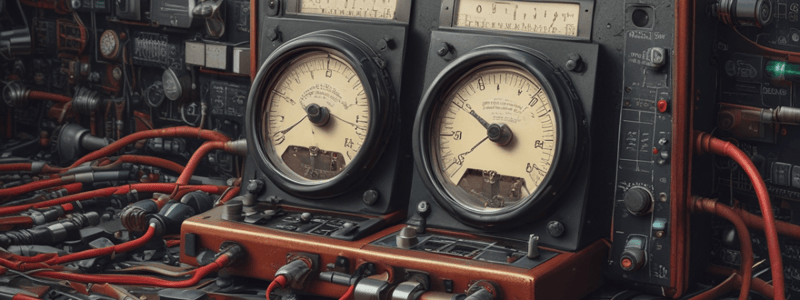Podcast
Questions and Answers
Adding an amplification circuit to a galvanometer helps boost its reading into measurable quantities.
Adding an amplification circuit to a galvanometer helps boost its reading into measurable quantities.
True (A)
Calibration is an unnecessary step when converting a galvanometer into a milliohmmeter.
Calibration is an unnecessary step when converting a galvanometer into a milliohmmeter.
False (B)
The milliohmmeter itself has coils of wire that move a pointed needle when electric charge flows through them.
The milliohmmeter itself has coils of wire that move a pointed needle when electric charge flows through them.
False (B)
In order to convert a galvanometer into a milliohmmeter, an amplification circuit and adjustments for accuracy need to be added.
In order to convert a galvanometer into a milliohmmeter, an amplification circuit and adjustments for accuracy need to be added.
Testing the performance of the converted device under various conditions is not necessary after conversion.
Testing the performance of the converted device under various conditions is not necessary after conversion.
A galvanometer measures electric currents by altering the magnetic field of an electromagnet.
A galvanometer measures electric currents by altering the magnetic field of an electromagnet.
Flashcards are hidden until you start studying
Study Notes
Basic Electrical Measurements
Converting Galvanometers to Milliampere Meters
Galvanometers measure electric currents using the deflection of a pointed needle attached to a coil of wire that moves when the magnetic field of an electromagnet is altered by the flow of electric charge through the wire. A milliohmmeter amplifies the output of a galvanometer so it can measure small currents. To convert a galvanometer into a milliohmmeter, you need to add an amplification circuit and adjustments for accuracy. Here's how to do it:
Step 1: Add Amplification Circuit
The first step is to add amplification circuits to boost the galvanometer's reading into measurable quantities. This can be done with operational amplifiers (op-amps) because op-amps have high input impedance and gain. With this configuration, even minute changes in the galvanometer will produce larger readings on the scale.
Step 2: Calibrate the Scale
To ensure accurate readings from your converted device, calibration is crucial. Start by making sure the pointer is centered on the zero mark on the scale. Then, apply known currents through the galvanometer and observe the resulting deflections. Adjust the scale until these deflections match their expected values.
Step 3: Test for Accuracy
After setting up the device, test its performance under various conditions. Apply different currents and compare them to the readings obtained after conversion. If there are any discrepancies, make further adjustments to improve the accuracy of the milliohmmeter.
Step 4: Convert to Milliampere Meter
Finally, to display current in milliampere units instead of microamperes, divide the largest number of divisions on the dial face by 5. For example, if the dial has 60 divisions per division, each division represents 60 / 5 = 12 mA.
Remember, while this method provides some level of accuracy, there may still be errors due to factors like temperature drift, mechanical vibrations, etc. Therefore, always check the accuracy of the instrument against a standard reference.
Studying That Suits You
Use AI to generate personalized quizzes and flashcards to suit your learning preferences.




